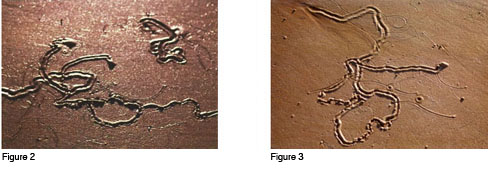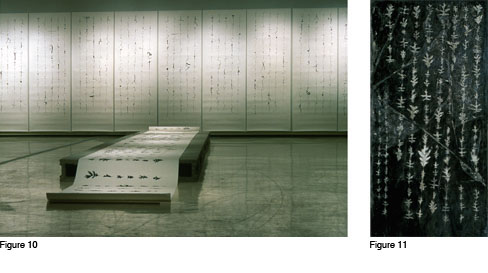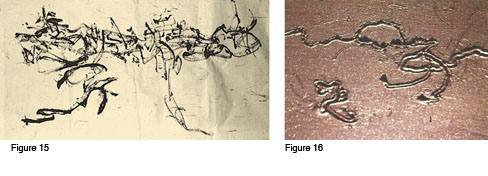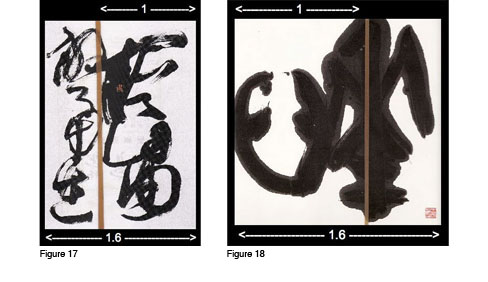| --------------------- WORK ------------ ABOUT ------------ PRESS ------------ NEWS ------------ LINKS ------------ CONTACT |
PATTERNS AND PATHWAYS: CUI FEI GET TO KNOW: CUI FEI 6 EIN FANTASIETEXT AUS 6 CUI FEI 6 6 INTERVIEW WITH CUI FEI 6 NATURE AND CALLIGRAPHY 6 CUI FEI
TRACING THE ORIGIN 6 TAKING ANOTHER LOOK 6 6 ARTIST OF THE MONTH: 6 6 A LOOK AT CUI FEI 6 SEVEN ENIGMATIC 6 REASON'S CLUE EXHIBIT 6 WHERE BRIEF WORKS 6 CUI FEI AT GALLERY 456
/////////
AN INTERVIEW WITH
|
NATURE AND CALLIGRAPHY by Britta Erickson
To talk about calligraphy and nature is to talk about humans and nature. Although the written word is the exclusive production of human civilization, and calligraphy is the most elite form of the written word, if we investigate the impetus for calligraphy, and the forms calligraphy takes, we find we are led back to the connection between humans and nature. Indeed, we may forget that humans are part of nature’s vast spectrum, but the fact that such a pure expression of the human spirit as calligraphy—and notably experimental calligraphy—turns back to nature should give us reason to stop and ponder the fact that we are all part of nature. Fuxi (later third millennium B.C.E.), one of the mythic Three Sovereign of ancient China, is said to have discovered the eight trigrams bagua (essential to the Yijing) on the back shell of a turtle, marking the beginning of writing. Human society was chaotic before the intervention of Fuxi, and the eight trigrams enabled him to impose order on the world. A second legend explaining the origin of writing states that Cang Jie was inspired by the natural patterns, the traces of nature—marks left by birds and animals—to invent writing. In both cases, instead of being systematically developed, that essential tool of human civilization, writing, was believed to be sparked by sudden inspiration, miraculously revealed via marks in nature. Now, contemporary experimental calligraphers return to nature, the original mythic source of writing, in their search for new calligraphic forms. Some such as Zhang Dawo (b. 1943) look to untamed nature, and others like Cui Fei (b. 1970) shape nature to their purpose.
In his investigation of calligraphic form and its connection to the natural world, Zhang Dawo has produced a group of photographs. (Figure 1) Like his image of plant stems and their reflection in the water, and others of reeds and grasses, some capture the strength of the calligraphic line, and the beauty of the line when it is not solid yet still strong, akin to feibai. One group of photographs, Footprint Art, captures the traces left by natural processes or by small creatures. (Figure 2) He has paired the photographs with musings by Zhang Qiang on the traces and their relationship to art. (Figure 3) One series in particular, Haitan zongji/chaoxi xilie (Beach trails/tide series), calls to mind Cang Jie’s invention of writing catalyzed by nature’s marks, capturing the trails of a sand snail. Even taking into consideration the fact that Zhang Dawo has selected the snail trail and framed it in his camera’s viewfinder, it is still fascinating to see how closely the trail calls to mind calligraphy. As the texts accompanying the photographs note, without artistic training and without culture, the tiny artist nevertheless produced an ephemeral work of art.
In an interview, Zhang Dawo has said, “The greatest artist is nature. Nature can paint, write, destroy and reshape. Works by nature are more beautiful than any man-made ones. All of my efforts are just trying to capture the beauty that nature has created. . . . I like wandering around the beach for discovery. Those snails are artists, and they paint on sands with their bodies. . . . They may not have consciousness of what they are doing, yet they boast the power and charm of being alive. . . . Many other things can touch me, such as the dry, rotted and fallen wood, its texture and the insect bites on it. All of these are works by nature, and they touched me deeply.” i Among Zhang Dawo’s calligraphic works are those whose sinuous lines recall the robust twists and turns of the snail’s path. (Figure 4) His best-known calligraphic manner combines such turns with a more overtly robust line, investing his works with both grace and power. (Figure 5)
As an aside, it should be noted that the impulse to search for script in nature is not confined to China. (Figure 7) Several photographic Roman alphabets have been assembled based on natural forms, including the patterns on butterfly wings. (Figure 8) But to search in nature for specific forms that have been regularized for print media cannot be so successful as to search for the kinds of lines and curves typifying Chinese calligraphy.
Cui Fei has witnessed much change in her life, first in China (where in 1993 she earned a BFA degree in Painting from the Zhejiang Academy of Fine Arts [now the China National Academy of Fine Arts]) and later in the United States, where she now lives. Finding a constancy in nature, she has developed a body of work where she takes small slightly variable items from nature and arranges them after the format of calligraphy. (Figure 9) The result is an elegant but unintelligible “text” that suggests that nature has much to tell us, but we must be sympathetic to the form of nature’s messages, rather than expecting them to be directly intelligible. One of those messages is simply the unsurpassed beauty of each tiny thorn and tendril.
In an artist’s statement, Cui Fei has written, “In response to a continually changing outside world, I seek the underlying essence of our lives, something that is real and permanent, which cannot be altered by social, political, cultural, or geographic conditions. I see nature as consistent and ordered, thus providing a therapeutic agent for healing and harmony in an otherwise chaotic world. I utilize materials found in nature, such as tendrils, leaves and thorns composing a manuscript symbolizing the voiceless messages in nature that are waiting to be discovered and to be heard.” ii Grape vine tendrils arrayed in vertical rows compose Cui Fei’s installation, Manuscript of Nature V(2002-present). (Figures 10-11) They closely mimic the format of a work of traditional Chinese grass style calligraphy, with a “title” on the top right, followed by the main body of the text, and finishing with the “signature” on the left. Viewed from afar, it could conceivably be legible, albeit idiosyncratic, calligraphy. Up close the beauty of the individual wooden twists pinned to the wall is revealed; they embody the same tensile strength as that cherished in calligraphy. When photographically reproduced on paper and mounted as hanging scrolls or handscrolls, the tendril or leaf “texts” even more closely resemble calligraphic works or art, for example in the 2000 installation Tracing the Origin I & II. (Figure 12.) While photography most accurately reproduces the tendrils’ and leaves’ forms, Cui Fei has been rendering them in other media, observing their evolution farther and farther from the “manuscript of nature.” An example where the “text” is more distant from nature is Manuscript of Nature I (1999). (Figure 13.) She has explained, “Chinese writing originated with images found in nature, changing with the progress and requirements of the times, becoming more abstract and simple. In the process of change, the original natural trace became blurred, even to the point where it can no longer be identified. This echoes the phenomenon of contemporary humanities [becoming increasing distant from its origins in nature]. [My] works take Chinese writing as an example, emphasizing the origin in traces, returning to nature, and emphasizing the importance of nature to the development of culture.” iii
In previous centuries, calligraphers have looked back to earlier and earlier forms of calligraphy for inspiration, studying beitie and then jiaguwen. They understood that as calligraphy had become more regularized, it had lost some of its original vitality. Zhang Dawo and Cui Fei have looked beyond pictographs to nature itself. Perhaps the fact that Chinese legend cites nature as the source of writing is a reflection of some kind of deep wisdom. That these artists look to nature is in part due to the times: the way culture and society is developing separates us from nature, with some increasingly obvious negative consequences. But even more to the point, Zhang and Cui seem to sense that aesthetic perfection exists in nature. I would like to finish my paper by raising an idea that has hovered at the edge of my mind for years. The idea is that, even without the artist’s conscious intent, calligraphic form is shaped by nature: as the Fibonacci Series and the Golden Number, Phi F, dictate the number of petals on a flower and the curve of a seashell’s spiral, so too might they shape the proportions and angles of calligraphy. Humans are a part of nature; thus their creations cannot stray unconsciously from nature-given forms, even though humans may consider themselves to be “above” nature. So, is it possible to find any link between their works, and the Fibonacci Series and the Golden Number, Phi F? This is actually a rich subject that could be the basis of a doctoral dissertation, but here I present it simply as something worth thinking about occasionally when looking at calligraphy. The Fibonacci Series begins with zero and one, and each subsequent number is the sum of the two previous numbers. (Figure 14.) Thus we have: 0, 1, 1, 2, 3, 5, 8, 13, 21, 34, 55, and so on. Most flowers have a number of petals from this series, and it also describes how leaves are arranged on plants. (Figure 15.) By fitting together squares whose sides are one of these numbers, we can derive the spiral that describes the spiral of snails’ shells, and of seeds in sunflowers, and many other things in nature. (Figure 16.) The mathematics required to determine whether the curves in calligraphy conform to this is too difficult for me.
(I have, however, noticed an almost exact correlation between a passage in one of Zhang Dawo’s calligraphic works and one of his photographs of sea snail trails, rotated 180 degrees. [Figures 17-18.]) But it is much easier to look at proportions (rather than curves) to determine if they relate to the Golden Number, which is based on the ratio between one number in the Fibonacci Series and the following number, and is close to 1:1.6. iv I have chosen calligraphic works with relatively simple compositions, and it is apparent that major compositional divisions occur at points relevant to this ratio. I would not be surprised if our aesthetic values were deeply tied to our appreciation of nature’s forms, and indeed to our status as a part of nature. Where calligraphy is most free, we might expect our connection to nature to be revealed.
Figure Legends
CRIENGLISH.com. Yang Tingting interview, “Zhang Dawo—The Natural Is the Beauty”, 2007-12-28 17:00:04. http://english1.cri.cn/4406/2007/12/27/1441@308574.htm (Accessed 1 June 2010.)Cui Fei. iii Cui Fei , Artist’s statement regarding Tracing the Origin VI, m.s. iv Ron Knott, “The Fibonacci Numbers and Golden Section in Nature – 1” (1996-2008) http://www.maths.surrey.ac.uk/hosted-sites/R.Knott/Fibonacci/fibnat.html#spiral (Accessed 5 June 2010.)
All material copyright 2010 by Britta Erickson. |










